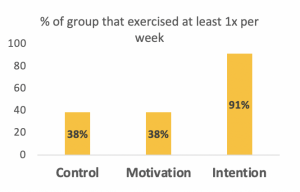
28 Jan 4 Unusual Tricks For Sticking to Your Health and Fitness Resolutions
Exercise Scientist & Injury Prevention Specialist, Lindsay Starling, Tells us How to Stick to Our Fitness Resolutions
It’s been one month of diving head first into your new year’s resolutions, including those two resolutions which seem to find themselves at the top of the list each year: ‘Eat healthier’ and ‘exercise more’. As we approach February, the motivation seems to be slipping and these two resolutions are slowly creeping down the priority list. Don’t beat yourself up, the human brain is wired to favour routine over novelty, even if the routine is unhealthy. A quick google on “how to stick to your new year’s resolutions” yields some fairly customary suggestions; here are 4 unfamiliar tips to help you stay on track.
1.Focus on the immediate feelings
Within these ‘eat healthier’ and ‘exercise more’ resolutions, you’ve most likely set yourself a more specific goal, whether it be to complete a half marathon or lose 5kgs. It’s great to have more focused objectives, but when the motivation is lacking, and progress is slow, these goals can feel like a life time away. It’s key to focus on how the small health changes you are making make you feel on a daily basis. Research shows us that people who focus on how movement makes them feel and function, are more likely to achieve their weightloss goal than those who focus purely on the distant goal. Be conscious and focus on how you feel throughout each day as a result of your health changes. Do you feel more awake after exercising in the morning? Less bloated and foggy brained after eating your healthier lunch choice? Less irritable after an exercise session?
2. Portion your goal into dopamine-friendly chunks
Within your larger health goal make sure to set small, obtainable goals and when you reach these small goals, relish in the accomplishment of it. When we achieve something, our brain releases dopamine, which is aptly referred to as the “feel good” neurotransmitter. Each time your brain gets a taste of this rewarding neurotransmitter it will want you to repeat that behavior so that it can get another taste. Enabling yourself to achieve your smaller goals and then enjoy the dopamine reward will motivate you to achieve your next goal with promise of your next dopamine chunk.
3. Motivation vs Intention

Researchers have conducted studies where they split people into two groups; a motivation and an intention group. The motivation group is given motivational pep talks and educational pamphlets on the benefits of exercise, while the intention group is required to explicitly state when and where they will conduct their exercise over the coming week. Participants in the intention group were almost 3x more likely to exercise in that week than the motivation group. When planning your calendar for the week, physically write in what type of exercise you intend on doing, where and for how long.
4. Find your type of accountability
Now that you’re feeling motivated and you’ve set your intention for your morning gym session, when your alarm goes off at 5:30a.m and your bed is feeling extremely cozy no one will know if you push your snooze button three more times, right? If you had promised your friend you would meet them at the gym however, you would most likely have gotten out of that comfy bed to go meet them. When you hold yourself accountable to your goals you are communicating that your goal is a priority. If you don’t share your goals in some way, it’s too easy to give up on them because it’s like they never really existed. Find a type (or combination) of accountability that works best for you as an individual.
- Find your motivational partner. Share you goal with a loved one who will support you through your goal and celebrate the small victories with you.
- Use technology. There are an abundance of Apps and websites to help you track your goals or to connect you with people with similar goals. Give LARK, FITSNAP or MYGOAL a try.
- Involve people. This can be as simple as telling a friend you will meet them at gym or will partner with them in your exercise class. Find a running group or join a Facebook group with people aiming to achieve similar goals.
- Spend money. Now don’t get me wrong, I’m not implying that it’s a necessity to purchase a gym contract or hire a personal trainer to achieve your fitness goals, but when you know you’ve spent your hard-earned money on something, you are more likely to make use of it in an effort to get something back in return. An example of this is pre-paying for an exercise class rather than only paying for it when you arrive. If you’ve paid for it and know it cannot be refunded, you will be more likely to attend it.



No Comments